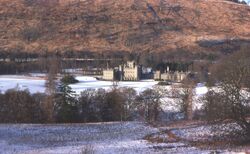Social:PYTHON
PYTHON was a Cold War contingency plan of the British Government for the continuity of government in the event of nuclear war.
Background
Following the report of the Strath Committee in 1955, the British government developed contingency plans for the continuity of government. This included construction of the Central Government War Headquarters (CGWHQ), codenamed BURLINGTON, at Corsham. As planned, it would have been a "reserve Whitehall" where the central government could be moved in an emergency and, hopefully, survive a nuclear attack. As nuclear weapons became more powerful and intercontinental ballistic missiles became more of a threat than manned bombers, the concept of concentrating central government in a single location became flawed. Instead government would be dispersed around the country with just core functions at CGWHQ. The Cuban Missile Crisis of 1962 prompted a radical rethink of continuity plans.[1] Part of the thinking was that the Precautionary Period ahead of nuclear war, or a conventional war in Europe culminating in nuclear war, might only last 2-3 days rather than the 7 days originally planned, so it would not be possible to fully staff CGWHQ with 4,000 people in time.[2]
PYTHON became active on 1 May 1968 and described in the 1968 update to the Government War Book.[3]
PYTHON locations
Sites for dispersing government were selected in 1966 based on their existing accommodation, independence from the national power and water grids, nuclear fallout protection and distance from likely targets. The chosen sites were RNAS Culdrose in Cornwall, HMS Osprey in Dorset, Taymouth Castle (then the Civil Defence Corps Training School) in Scotland and either the helicopter support ship RFA Engadine or royal yacht HMY Britannia which would embark a PYTHON group at Loch Torridon or Oban.[4] Tonfanau Camp was temporarily designated as the PYTHON location for Wales with a view to moving the site to the Old College at Aberystwyth University (which housed the University's Department of Physics) as soon as possible.[1] Each dispersed PYTHON group would be supported by dispersed sections of the United Kingdom Supply Agency and the National Air Transport Agency.
In addition, in 1964 the Secretary of State for Scotland ordered three ships - MV Hebrides, MV Clansman and RMS Columba - which were chartered to David MacBrayne Ltd as car ferries but could be converted to floating nuclear bunkers in a very short time. They had heavy steel doors to seal the car deck, air tight external windows and doors, decontamination rooms with showers and external sprinklers to wash away fallout. One or more of these ships would have accompanied RFA Engadine or HMY Britannia from Oban or Mallaig.[1]
The Corsham bunker, given the new codename TURNSTILE from 1963 and CHANTICLEER from 1970, would play an important part in the lead up to war but ceased to have a CGWHQ role other than as a possible aggregation point for PYTHON groups some time after an attack.[2]
References
- ↑ 1.0 1.1 1.2 "How Scotland and three CalMac ferries played a crucial part in nuclear planning". The Herald. 22 January 2017. http://www.heraldscotland.com/news/15039649.How_Scotland_and_three_CalMac_ferries_played_a_crucial_part_in_nuclear_planning/.
- ↑ 2.0 2.1 Peter Hennessy (2014). The Secret State: Preparing For The Worst 1945 - 2010. Penguin. p. 141. ISBN 0141979208.
- ↑ CAB 21/5655 Government War Book, The National Archives
- ↑ "If nuclear war had broken out between Russia and the west, HMS Osprey on Portland would have been a remote hideaway for the government". Dorset Echo. 28 January 2017. http://www.dorsetecho.co.uk/news/15053819.The_top_secret_story_of_just_how_important_Portland_could_have_been_in_the_Cold_War/.



